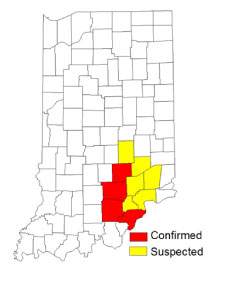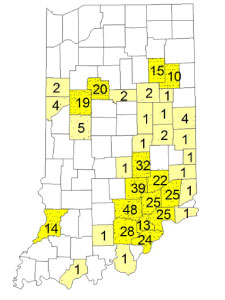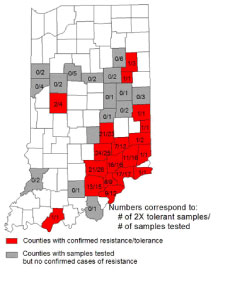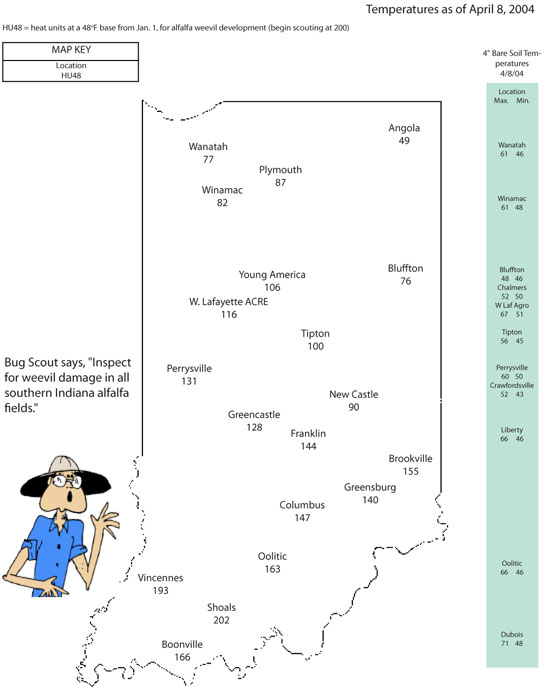Pest & Crop Newsletter
|
|||||||
Alfalfa Weevil Damage Beginning in Southern Indiana– (John Obermeyer and Larry Bledsoe)
The flowers are blooming, the farm equipment is rolling, and alfalfa weevil are beginning to feed... spring is here! Betsy Smith, Grower’s Co-op near Terre Haute and Don Biehle, at Southeast Purdue Agricultural Center near Butlerville, reported the beginning of alfalfa weevil feeding. This correlates quite well with the heat unit accumulations in those areas. In other words, it’s time to start scouting alfalfa for weevil damage in the southern counties of Indiana.
Field scouting for alfalfa weevil damage should begin when approximately 200 heat units, base 48°F, have accumulated from January 1 (see “Weather Update” for locations near you). Sampling a field to determine the extent of alfalfa weevil damage and average stage of weevil development is best accomplished by walking through the field in an “M-shaped pattern.” Ten alfalfa stems should be examined in each of 5 representative areas of the field for a total of 50 stems from the entire field. Consider that south facing slopes and/or sandy soils warm sooner and should be included in the sampling. Each stem should be examined for: (1) evidence of tip feeding by alfalfa weevil larvae; (2) maturity of the stem, i.e., pre-bud, bud and/or flowers; and (3) stem length. The average size (length) of weevil larvae should also be noted. Although large alfalfa weevil larvae are relatively easy to find, small larvae are difficult to see; thus, very close examination of leaves may be required to detect “pin-hole” feeding and small larvae. By utilizing heat unit accumulation data to determine when sampling should begin and when a management action should be taken, producers can get the greatest economic return. If the application of an insecticide is required early in the weevil season, producers have the option of using a material that has good residual action. Later in the season, short residual insecticides should be used and producers should pay close attention to harvest restrictions. Management guidelines, which are based on heat unit accumulations, will be given in next week’s Pest&Crop.
Weeds and Cutworms– (John Obermeyer and Larry Bledsoe)
As reported in this and last week’s “Black Cutworm Adult Pheromone Trap Report,” this insect has begun its arrival into the Midwest. Todd Hutson, Vermillion County CES, monitors both a pheromone and black light trap. He’s reported the capture of variegated cutworm moths in the black light trap. Unlike the black cutworm, the variegated cutworm overwinters here. This cutworm species can damage corn and soybean, especially in fields with chickweed “carpets.” Both of these cutworm moths are particularly attracted to winter annuals, such as chickweed and mustards in which to lay their eggs. Fields that are showing plenty of green are at highest risk for cutworm damage. Corn and soybean are the cutworm’s least favorite foods, it just so happens these are the only plants remaining by the time larvae have emerged and weeds have been killed. Research has shown that cutworm larvae starve if weeds are treated with tillage or herbicide 2-3 weeks before crop emergence. Something to be said for controlling weeds in order to manage insect pests.
Click for Table.
|
|||||||
Update on the Occurrence of Glyphosate-Resistant Marestail/Horseweed- (Bill Johnson, Glenn Nice, and Jeff Barnes)
We reported last year that glyphosate-resistant marestail had been discovered in four southeast Indiana counties following the 2002 season. Greenhouse trials on two of those populations proved that these marestail populations tolerated at least a 4X rate of glyphosate (88 oz Roundup WeatherMAX/A or 3 lb ae/A). Conversations with producers and crop advisors during the winter of 2003 indicated that the problem was not confined to those four fields but appeared to be more widespread and included the majority of counties in southeast Indiana (Figure 1). Other areas of the United States such as the Delaware and Tennessee began experiencing problems with control of horseweed with glyphosate during the summer of 2000 in isolated fields. Just two years passed before weed scientists in both states came to the conclusion that resistance was widespread across the landscape. Resistant horseweed was believed to infest 400,000 acres in Tennessee alone following the 2002 cropping season. An effort was established last year to get a grasp on how severe the glyphosate-resistant marestail problem is in Indiana. During September and October of 2003, an intensive field survey was conducted to determine the frequency of occurrence of glyphosate-resistant marestail in Indiana. This effort concentrated primarily in southeast Indiana, but several counties were intensively surveyed in the southwest and northern regions as well. We also established a sampling form with sample collection and submission instructions that producers and crop advisors could download for sample
The fall sampling effort involved visiting 792 cropped and non-cropped sites in Indiana. Fourteen counties were sampled intensively (more than 10 samples per county) and additional seed samples were collected or submitted from an additional 21 counties (Figure 2). A total of 389 samples were collected. Of the 389 collected, 222 were from soybean or corn fields, or wheat stubble (215 samples were from soybean fields as this was the target crop for the field survey). During the survey trips, information was also collected from each field regarding the crop, field tillage system, and the distribution and relative density of marestail within a field. Over the last few months we have been conducting screening trials in the greenhouse on these marestail populations. The screening efforts consisted of 2X applications of glyphosate (Roundup WeatherMAX 44 oz/A or 1.50 lbs ae/A) made when marestail rosettes were 2 to 3 inches in diameter. The populations were compared to known susceptible and resistant populations to determine if they were tolerant to glyphosate. Figure 3 shows the typical response we have seen in these greenhouse trials. In the greenhouse where conditions are optimal to achieve very good control, susceptible plants begin to appear yellow and stunted in 4 to 5 days with total plant death in 10 to 14 days after glyphosate application. Resistant plants also appear stunted with distinctive yellowing of older tissue by 4 to 5 days after treatment. Instead of dying, older plant tissue appears to recover slightly and new growth begins to appear from the center of the rosette. Once the new growth begins to develop, plants appear to grow at the same rate as non-treated plants despite the 20 to 40% stunting that occurred within the first 7 days after application.
To date we have tested 217 populations for tolerance to 2X applications of glyphosate. We are finding that many of the populations are tolerant to 2X glyphosate applications. Figure 4 shows the number samples tested for resistance in each county (bottom number) and the number of samples that were tolerant to glyphosate (top number). In the future we will screen the tolerant populations with a 4X glyphosate application, which is considered by many experts a rate which separates tolerance and true resistance. From a practical standpoint, rosette stage marestail that survives a 2X application of glyphosate will present a problem for producers regardless of whether the plants are considered resistant or tolerance. Producers and crop advisors in southeast Indiana especially should be aware that an overwhelming majority of populations from that area are demonstrating tolerance to glyphosate. Based upon our screening efforts we have confirmed resistance to glyphosate in 19 Indiana counties, some as far north as Wells and Blackford counties and as far west as Spencer and Montgomery counties. Despite the discovery of resistance/tolerance in Montgomery and Wells counties, our survey efforts have lead us to believe that resistance is not widespread in these areas. Widespread resistance/tolerance observed in southeast Indiana may be delayed or prevented in the northeast and west-central regions of the state if we begin to manage for resistance by incorporating alternative modes of action for marestail into our herbicide programs. Our current recommendations are to start-early in trying to control this weed and other winter annuals in no-till and conservation tillage fields. Include 2,4-D in the burndown treatment at a rate of 1-2 pt/A (check label as many formulations are available) in any burndown applications in southeast Indiana and in other counties in which resistance is suspected or confirmed. Closely monitor the size of marestail as both glyphosate and 2,4-D are much less effective on marestail when it reaches 6 inches or more in height. In most of Indiana this should not occur before May 1, so time remains for effective control this year. It is rather unclear at this point what role spring emergence of marestail plays in some of the control failures we have seen over the past few seasons. Many fields may have a significant amount of spring emergence, particularly in southeast Indiana and this can be reduced by including residual herbicides such as FirstRate, Sencor, Valor, Authority, Canopy XL, Gangster, or Python in the burndown application. We are continuing our monitoring efforts this year and would appreciate any information that can be provided concerning new fields that have experienced control failures. If you are in doubt about a particular field or weed concerning possible reasons for herbicide escape, please contact Jeff Barnes, Bill Johnson, or Glenn Nice. The sampling and survey efforts would not be possible without financial support from the following organizations; Purdue University Ag Research Programs, Indiana Soybean Board, Monsanto, Syngenta, Dow AgroSciences, BASF.
|
|||||||
|
|||||||








